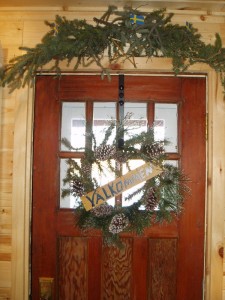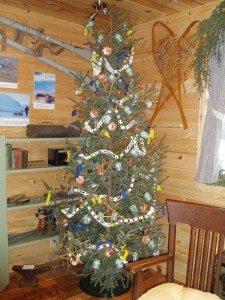In the early 1900s, Scandinavian settlers, consisting mostly of Swedes, homesteaded on the east side of the Winnipeg river, opposite the village of Lac du Bonnet. This district became known as Riverland.
Some of the early Swedish pioneer family names in Riverland were Lindgren, Nasstrom, Petterson, Ongman, Pearson, Rosenholm, Tinndal, Anderson, Erickson, Hendrickson, Magnusson, Johnsson, and Larson.
The Swedes proved to be successful in farming, construction, logging, carpentry, and other trades. Some men worked construction at Pinawa Power Plant, 1902 – 1906, Pointe du Bois Power Plant until 1911, the brick plant, and McArthur’s sawmill in Lac du Bonnet.
Their homes were hand hewn dovetailed log construction, chinked with moss and plastered with a mixture of clay, cow manure, and straw. Some were white washed with a mixture of lime and water.
They worked hard making a living off the land by farming, trapping, hunting, and fishing. Water was acquired from the river year round. Cash was scarce. Cordwood was plentiful, and many eked out their farm living cutting and hauling wood to town to trade for flour, sugar, and coffee.
There were no cars, and no roads. Travel was by walking, through brushed trails, and around swamps, horseback, teams of oxen, or rowboat on the river.
The Swedish community was close in faith, work, and play. Neighborhood get togethers and community events were a very important factor to their unity. A school, church, and community hall would soon follow.
School Point – Riverland 1910 -1922
A log one room schoolhouse and a teacherage were built at School Point (today marked at Anderson Way and Davies Road). Built by community volunteers between 1910 and 1914, on donated land, it was to serve the children of the Swedish families who had settled in the Riverland area.
The first teacher was Naima Erickson (nee Bergstrom) who taught grades one to eight. Within several years the school had an enrollment of 22 students. It was closed in 1922 and the children later attended the new Riverland School further East.
A building called the Pavilion was erected on the South line to serve as a gathering place. This pavilion was owned by the school, and many of the sporting and cultural activities held at School Point took place there.
In the summer, School Point served as the site for a ferry landing. The ferry owned by K.J. Erickson made the necessary connection across the river. It was used to assist in the barging of equipment needed for the construction of the Pinawa Hydro Electric Generating Station.
from MHAC Cairn on site
Riverland School District 1557
The second Riverland school was used from 1922 – 1966. It still stands on its original location, along with the teacherage, on Riverland Road. At one time fifty to sixty pupils from grades one to eight attended this one room schoolhouse. In the early years children had to walk one to four miles to attend school.
Riverland Hall
Known as the Riverland Recreation Association, this hall was situated across the road from School Point. The Riverland community pooled together their resources, with donated land, materials, and labour. The end result was a hall with a dance floor, loft, stage and kitchen. (used until the 1960s)
Ebenezer Lutheran Church Riverland Rd. and Anderson Way
In 1912, Lutheran church services were first held at the log schoolhouse in School Point. Later, 1925, they were held at the Riverland School #2, and then moved to Riverland Hall. The congregation grew and with a land donation of ½ acre by Frank Pearson, building committee led by Emil Naastrom, (who also carried the loan till it was paid off in 1946), chimney built by Axel Lindgren, the completion of the church became a reality in 1931. With amalgamation with Lac du Bonnet it dissolved in 1959.
Silver Lodge
Silver Lodge was opened in the 1920s by Mr. and Mrs. Nels Eric Johnson (Johnsson). It was a popular summer resort for tourists, with board and room available at $15.00 a week. There were several small cabins, and Saturday night dances were held at the lodge. (used until1954 raising of the water level)
 “A Swedish Christmas on the Prairies”
“A Swedish Christmas on the Prairies”
On November 29, 2011, the Lac du Bonnet Museum had the pleasure of sharing with grades one and two from the Centennial School in Lac du Bonnet a traditional Swedish pioneer Christmas celebration. The Hans Erickson cabin was filled to the brim with Swedish décor. The traditional tree boasted handmade paper chains, Swedish flag garland, advent stars, but most importantly the beautiful reindeer each child made and brought with them and put on the tree. Museum staff shared the customs of Sweden with the students, which were common on a Swedish homestead in western Canada. A few games were played, and everyone listened to beautiful carols sung by Iona Plato. The children listened to the stories of the Swedish homesteaders that came and settled in the Riverland area on the East side of the Winnipeg River. The students learned a few Swedish words, listened to poems and short stories, shared some laughter, and enjoyed a visit from Santa or “Jultomten”, who gave them a special “Swedish” treat to take home.
Feedback received from Centennial School
The presentation you created for our Grade 1/2 students was outstanding. The decorating, the selection of music and readings, the game and visit from Santa were all perfectly planned for children of this age. One of the reasons our children were well behaved was because they were engaged in the learning at the museum. You drew them in.
More importantly, from my perspective, was the idea that a group of loving adults carefully planned for the education of children in our community. The saying, "It takes a community to raise a child" was lived yesterday. I tried not to get teary when the little boy on my lap asked, "Can I go hug Santa?". I don't think he will ever forget telling Santa that he missed him and loved him and hearing Santa say, "I missed you too" and "I love you too".
The care that was given to your first educational presentation leads me to believe there will be a successful  liaison between the museum and our school for years to come.
liaison between the museum and our school for years to come.
Congratulations and many thanks! Leslie
Leslie Wakeman
Guidance and Counseling
Centennial School
November 30, 2011
The following day, the museum was open to the public for two readings first at 7:00 and the second at 8:00. “A Swedish Christmas on the Prairies” was again well received.
Click on pictures to enlarge, To see more pictures of the this event click; Swedish Christmas.